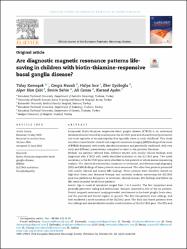| dc.contributor.author | Kamaşak, Tülay | |
| dc.contributor.author | Havalı, Cengiz | |
| dc.contributor.author | İnce, Hülya | |
| dc.contributor.author | Eyüboğlu, İlker | |
| dc.contributor.author | Çebi, Alper Han | |
| dc.contributor.author | Şahin, Sevim | |
| dc.contributor.author | Cansu, Ali | |
| dc.contributor.author | Aydın, Kürşad | |
| dc.date.accessioned | 10.07.201910:49:13 | |
| dc.date.accessioned | 2019-07-10T19:52:40Z | |
| dc.date.available | 10.07.201910:49:13 | |
| dc.date.available | 2019-07-10T19:52:40Z | |
| dc.date.issued | 2018 | en_US |
| dc.identifier.citation | Kamaşak, T., Havalı, C., İnce, H., Eyüboğlu, İ., Çebi, A. H., Şahin, S. ve Aydın, K. (2018). Are diagnostic magnetic resonance patterns life-saving in children with biotin-thiamine-responsive basal ganglia disease? European Journal of Paediatric Neurology, 22(6), 1139-1149. https://dx.doi.org/10.1016/j.ejpn.2018.06.009 | en_US |
| dc.identifier.issn | 1090-3798 | |
| dc.identifier.issn | 1532-2130 | |
| dc.identifier.uri | https://dx.doi.org/10.1016/j.ejpn.2018.06.009 | |
| dc.identifier.uri | https://hdl.handle.net/20.500.12511/2440 | |
| dc.description | WOS: 000455065100029 | en_US |
| dc.description | PubMed ID: 30054086 | en_US |
| dc.description.abstract | Background: Biotin-thiamine responsive basal ganglia disease (BTBGD) is an autosomal recessive disorder caused by mutations in the SLC19A3 gene and characterized by recurrent sub-acute episodes of encephalopathy that typically starts in early childhood. This study describes characteristic clinical and magnetic resonance imaging (MRI) findings of six cases of BTBGD diagnosed with newly identified mutations and genetically confirmed, with very early and different presentations compared to cases in the previous literature. Methods: Six patients referred from different centers with similar clinical findings were diagnosed with BTBGD with newly identified mutations in the SLC19A3 gene. Two novel mutations in the SLC19A3 gene were identified in two patients at whole exome sequencing analysis. The clinical characteristics, responses to treatment, and electroencephalography (EEG) and MRI findings of these patients were examined. The other four patients presented with similar clinical and cranial MRI findings. These patients were therefore started on high-dose biotin and thiamine therapy, and mutation analysis concerning the SLC19A3 gene was performed. Responses to treatment, clinical courses, EEG findings and follow-up MRI were recorded for all these patients. Results: Age at onset of symptoms ranged from 1 to 3 months. The first symptoms were generally persistent crying and restlessness. Seizures occurred in five of the six patients. Cranial magnetic resonance imaging revealed involvement in the basal ganglia, brain stem, and the parietal and frontal regions in general. The first two patients were siblings, and both exhibited a novel mutation of the SLC19A3 gene. The third and fourth patients were also siblings and also exhibited a similar novel mutation of the SLC19A3 gene. The fifth and sixth patients were not related, and a newly identified mutation was detected in both these subjects. Three novel mutations were thus detected in six patients. Conclusion: BTBGD is a progressive disease that can lead to severe disability and death. Early diagnosis of treatable diseases such as BTBGD is important in order to prevent long-term complications and disability. | en_US |
| dc.description.sponsorship | Karadeniz Technical University Scientific Research Projects Unit | en_US |
| dc.description.sponsorship | This study was funded by Karadeniz Technical University Scientific Research Projects Unit. All procedures performed in studies involving human participants were in accordance with the ethical standards of the institutional and/or national research committee and with the 1964 Helsinki declaration and its later amendments or comparable ethical standards. The requisite permissions were received from patients'families before the genetic tests. | en_US |
| dc.language.iso | eng | en_US |
| dc.publisher | Elsevier Sci Ltd | en_US |
| dc.rights | info:eu-repo/semantics/openAccess | en_US |
| dc.subject | Biotin-Thiamine Responsive Basal Ganglia Disease | en_US |
| dc.subject | BTBGD | en_US |
| dc.subject | SLC19A3 Mutations | en_US |
| dc.subject | Encephalopathy | en_US |
| dc.title | Are diagnostic magnetic resonance patterns life-saving in children with biotin-thiamine-responsive basal ganglia disease? | en_US |
| dc.type | article | en_US |
| dc.relation.ispartof | European Journal of Paediatric Neurology | en_US |
| dc.department | İstanbul Medipol Üniversitesi, Tıp Fakültesi, Dahili Tıp Bilimleri Bölümü, Çocuk Sağlığı ve Hastalıkları Ana Bilim Dalı | en_US |
| dc.authorid | 0000-0003-1513-6149 | en_US |
| dc.identifier.volume | 22 | en_US |
| dc.identifier.issue | 6 | en_US |
| dc.identifier.startpage | 1139 | en_US |
| dc.identifier.endpage | 1149 | en_US |
| dc.relation.publicationcategory | Makale - Uluslararası Hakemli Dergi - Kurum Öğretim Elemanı | en_US |
| dc.identifier.doi | 10.1016/j.ejpn.2018.06.009 | en_US |
| dc.identifier.wosquality | Q1 | en_US |
| dc.identifier.scopusquality | Q1 | en_US |


















